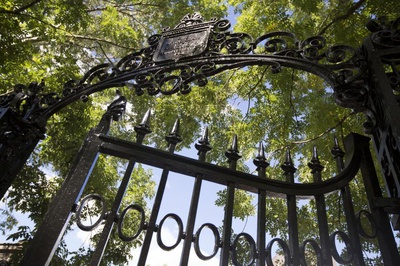
News
Harvard Grad Union Agrees To Bargain Without Ground Rules

News
Harvard Chabad Petitions to Change City Zoning Laws

News
Kestenbaum Files Opposition to Harvard’s Request for Documents

News
Harvard Agrees to a 1-Year $6 Million PILOT Agreement With the City of Cambridge

News
HUA Election Will Feature No Referenda or Survey Questions
‘Make It Easy, Make it Tasty’: How Harvard’s Dining Services Influences Student Food Choices

In Harvard’s dining halls, every array of food has been carefully constructed.
Harvard University Dining Services selects particular tray placements, serving station names, and menus based on student preferences to meet sustainability and local sourcing goals.
According to Director of Residential Dining Operations Barbara L. Kempken, HUDS nudges students to choose healthier food options.
Kempken said one intentional HUDS effort is “making sure fruit — fresh fruit — is visible.” In particular, she pointed to the Adams House dining hall, where the fruit basket is always on display and located close to the desert selection.
“It’s putting those things together,” Kempken said. “So you’re like, ‘Oh, I wanted a cookie. Oh, no, wait, that plum looks really good. Let me grab that.’”
“And then, same thing with soda, having the sparkling water and the soda near one another, so that it’s just as easy as an option,” she added.
The placement of vegetables before meat in dining hall serving lines also pushes students towards eating more foods with smaller carbon footprints — a stated goal of HUDS that includes reaching a 38 percent food-related emission reduction per plate by 2030.
Though Harvard has experimented with initiatives like “Meatless Mondays” to reduce carbon emissions in dining, HUDS has seen better results by simply injecting more intentionality into tray placement.
Last year, Harvard students ate 200 percent more chicken and plant-based foods and 20,000 fewer beef burgers, contributing to an 18.5 percent reduction of food-related emissions per plate.
According to the Green Restaurant Association, Harvard is the “Greenest University” — a distinction awarded to the University or College with the most dining halls certified to be “Green Restaurants” based on dining hall practices in areas including energy, water, waste, and disposables.
To encourage students to eat more sustainably, HUDS has also expanded their salad bar offerings and rebranded the “Greens and Grains” station.
“We don’t call it the ‘Salad Bar’ anymore — that itself adds more deliciousness and full meals for students, where it’s not the side anymore, it’s a complete bowl. That has an impact,” said Martin T. Breslin, HUDS director for culinary operations.
Director for Strategic Initiatives and Communications Crista Martin pointed to the large salad bowls that are placed at the station.
“The bowl itself invites you to make a full meal out of that station when, once upon a time, it might have been a much shallower bowl that didn’t make it simple for you to treat that as its own contained full meal experience,” Martin said.
Similarly, the ‘delish’ counters — offered at each house grill — encourage students to sample unfamiliar local vegetables.
“When you come in for lunch, you just take it off the grill,” Breslin said. “It’s a way of familiarizing students with vegetables that they may not otherwise see, like Belgian endive, which is grown locally.”
Beyond the strategic placements of food and behind the scenes, HUDS also designs menus around local sourcing and seasonal availability, including for seafood.
“Rather than dictating the catch by putting it on the menu, we look to what’s coming in from the boats,” Breslin said. “In the land of supplies, we take the demand.”
Breslin also pointed to the importance of student preference and input in HUDS’ menu determinations, particularly through the “Text and Tell” program, which was launched in 2017.
“We listen very carefully to your Text and Tells. All the Text and Tells are read by every one of us,” Breslin said. “And we take note of what students are asking us for.”
Three years ago, one of the most popular student requests was to increase vegetarian offerings, according to Smitha S. H. Haneef, the HUDS managing director.
“The biggest driver in our survey was, ‘Where is the vegan, where is the vegetarian entrees?’” Haneef said. “Then we literally have to go looking for: ‘How do we incorporate that?’”
After introducing dishes, HUDS then carefully tracks student reception.
“If you will eat it, we will serve it. If you eat less of it, we’ll serve less of it,” Martin said. “Sometimes we’re nudging you, and sometimes you’re nudging us.”
“When you don’t tell people what to do, when you give them choice — and it’s delicious choice — very often they will start to try new things and lean into those moments and those opportunities,” Martin said. “That’s the nudge: make it easy, make it tasty, and make it equitable.”
—Staff writer Xinni (Sunshine) Chen can be reached at sunshine.chen@thecrimson.com. Follow her on X @sunshine_cxn.
—Staff writer Christie E. Beckley can be reached at christie.beckley@thecrimson.com. Follow her on X @cbeckley22.
Want to keep up with breaking news? Subscribe to our email newsletter.
From Our Advertisers

Over 300+ courses at prestigious colleges and universities in the US and UK are at your disposal.

With innovative financial tools combined with financial education, Collegiate empowers students to take control of their finances and build confidence in their money management skills.

Serve as a proctor for Harvard Summer School (HSS) students, either in the Secondary School Program (SSP), General Program (GP), or Pre-College Program.

With an increasingly competitive Law School admissions process, it's important to understand what makes an applicant stand out.

Welcome to your one-stop gifting destination for men and women—it's like your neighborhood holiday shop, but way cooler.

Admit Expert is a premium MBA admissions consulting company, helping candidates secure admission to top B-schools across the globe with significant scholarships.
